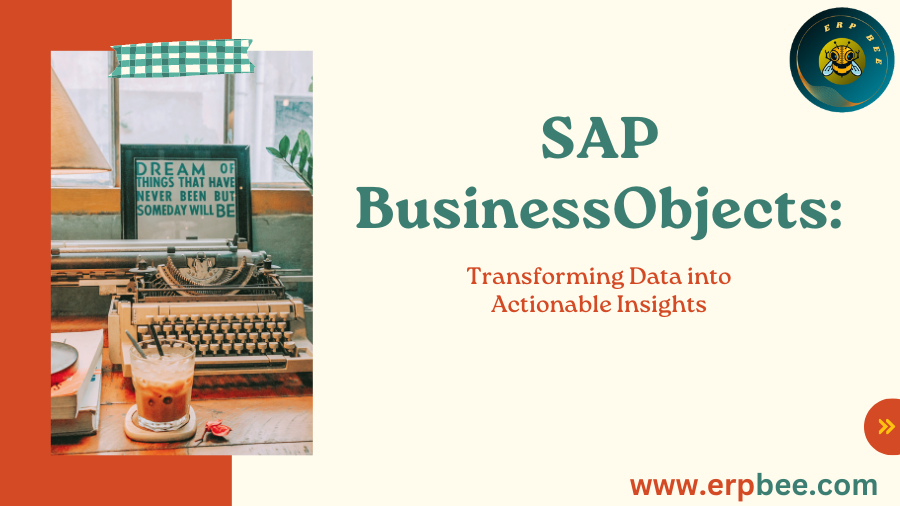Introduction: In today's data-driven business landscape, organizations face the challenge of managing and harnessing vast amounts of data to make informed decisions. SAP BusinessObjects, a powerful business intelligence (BI) platform, serves as a strategic tool for businesses to transform raw data into actionable insights. In this blog, we will delve into the key features, benefits, and functionalities of SAP BusinessObjects, and understand how it empowers organizations to achieve their strategic objectives.
What is SAP BusinessObjects?
SAP BusinessObjects is a comprehensive suite of BI tools and applications that enable organizations to access, analyze, and visualize their data. It provides a user-friendly and interactive interface that allows business users to explore data independently and derive valuable insights without relying on IT support. SAP BusinessObjects is part of the SAP Analytics portfolio, and it is designed to work with various data sources, including SAP and non-SAP systems.
Key Features and Functionalities
Data Connectivity: SAP BusinessObjects supports seamless integration with a wide range of data sources, including SAP applications, databases, spreadsheets, cloud-based systems, and more. This connectivity ensures that data from various sources can be accessed and analyzed within a single platform.
Reporting and Dashboards: One of the primary features of SAP BusinessObjects is its robust reporting and dashboarding capabilities. It offers a variety of reporting tools that enable users to create highly visual and interactive reports and dashboards. These reports can be customized to suit specific business requirements, making it easier to share insights with stakeholders.
Ad-Hoc Analysis: SAP Business Objects allows business users to perform ad-hoc analysis on their data, enabling them to answer spontaneous questions and explore data in real-time. This self-service BI capability empowers users to gain deeper insights without depending on IT support for data exploration.
Data Exploration and Visualization: With a wide array of chart types and visualization options, SAP Business Objects enables users to present data in a meaningful and easily interpretable manner. Data visualization aids in identifying trends, patterns, and outliers that might not be evident in traditional tabular data.
Self-Service BI: SAP BusinessObjects promotes a self-service BI approach, enabling business users to access and analyze data independently. This empowers them to create personalized reports and dashboards based on their unique requirements, reducing the burden on IT teams.
Mobile BI: In today's mobile-centric world, SAP BusinessObjects offers mobile BI capabilities that allow users to access reports and dashboards on their smartphones and tablets. This ensures that critical insights are available on the go, empowering users to make data-driven decisions anytime, anywhere.
Benefits of SAP BusinessObjects
Improved Decision-Making: SAP Business Objects provides real-time and accurate data analysis, enabling faster and more informed decision-making at all levels of the organization. It helps users identify trends, spot opportunities, and make proactive decisions.
Enhanced Business Performance: By monitoring key performance indicators (KPIs) and tracking business metrics through SAP Business Objects, organizations can optimize their processes and improve overall performance.
Centralized Data Repository: SAP Business Objects offers a centralized repository for storing reports and data, ensuring data consistency and providing a single source of truth for business users.
Scalability and Flexibility: SAP Business Objects' scalable architecture allows organizations to expand their BI capabilities as their data and user requirements grow. It can seamlessly integrate with various applications and data sources, providing flexibility in data analysis.
Cost-Effectiveness: SAP Business Objects reduces the dependency on IT teams for generating reports and conducting data analysis. By empowering business users with self-service BI, it leads to cost savings and increased efficiency.
Integration with SAP and Non-SAP Systems: SAP BusinessObjects' ability to integrate with both SAP and non-SAP systems allows organizations to leverage data from multiple sources, providing a holistic view of their operations.
Implementation Considerations
Implementing SAP BusinessObjects requires careful planning and considerations to ensure successful adoption. Here are some key implementation factors:
Needs Assessment: Begin with a thorough needs assessment to understand the specific BI requirements of your organization. Identify key stakeholders and involve them in the decision-making process.
Data Governance: Establish data governance policies to ensure data accuracy, security, and compliance. Define data access levels and user roles to maintain data integrity.
Data Integration: Ensure that SAP BusinessObjects is integrated with relevant data sources, including SAP and non-SAP systems. Assess data quality and perform data cleansing if required.
User Training and Adoption: Provide comprehensive training to end-users to help them utilize SAP BusinessObjects effectively. Encourage user adoption by demonstrating how it can add value to their day-to-day tasks.
Security and Access Control: Implement robust security measures to protect sensitive data and ensure that access to information is granted based on user roles and responsibilities.
Conclusion
SAP Business Objects is a powerful BI platform that empowers organizations to unlock the true potential of their data, enabling data-driven decision-making and propelling growth. With its user-friendly interface, data visualization capabilities, and seamless integration with SAP and non-SAP systems, SAP BusinessObjects provides a comprehensive solution for organizations seeking to derive actionable insights from their data. By embracing SAP BusinessObjects, organizations can stay ahead in the competitive landscape, identify new opportunities, and make informed decisions that lead to success.
